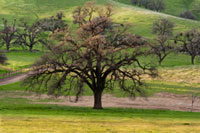Books
Finding and Using U.S. Army WWI and WWII Morning Reports: A Research Guide for Historians and Genealogists (Research Guides for Historians and Genealogists Book 2)
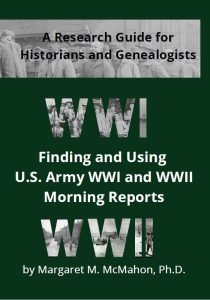 A book has finally arrived to show how you can travel back in time through locations and events, day by day, with a U.S. Army soldier or organization during WWI or WWII military service. With Morning Reports, you can overcome and potentially go beyond burned Army personnel files! Pursue references for a specific soldier, then leverage daily records even when not named or identified.
A book has finally arrived to show how you can travel back in time through locations and events, day by day, with a U.S. Army soldier or organization during WWI or WWII military service. With Morning Reports, you can overcome and potentially go beyond burned Army personnel files! Pursue references for a specific soldier, then leverage daily records even when not named or identified.
This book introduces techniques for locating Morning Reports and what is and is not included. WWI and WWII formats are described in detail, with examples allowing the reader to experience the WWII Morning Report language and abbreviations by utilizing the web, Fold3 (WWI) and the NARA catalog (WWII). The reader will discover tips for locating elusive reports and strategies for working around missing records. Useful case studies combine reports across parts of a military organization and place a soldier into the context of history. This book contains a bonus chapter about the daily reporting for other branches of the military.
Historians will find the search techniques and pointers to additional records useful as they track a soldier or organization through a world war.
Dr. McMahon has decades of experience as a professional educator and engineer. She researches, lectures and has authored numerous books about military history and genealogy. She is the Unofficial Historian of the 51st Pioneer Infantry Regiment.
Finding and Using U.S. Army WWI and WWII Morning Reports: A Research Guide for Historians and Genealogists (Research Guides for Historians and Genealogists Book 2) can be purchased through Amazon online in both print and Kindle versions online.
BUY THE BOOK
Crash Course on ChatGPT and Learning A Language
 Have you ever wanted a private tutor to help you learn a foreign language? Have you wished for lessons that were customized just for you? While nothing can replace being part of a community of people fluent in a language, ChatGPT can tap into its vast knowledge to provide you with a patient and tireless personal tutor- all you have to do is ask. It can even map out an entire course for you to follow. You can learn using the suggested lessons, then have ChatGPT test you with quizzes and puzzles, or converse with you (in text). It can even generate written content in a different language for you to read or translate. The book will get you started with the skills needed in prompt engineering when learning a new language. In the sections of this book, you will learn how to get an account and start using ChatGPT. Then you will find ideas on how to use ChatGPT to learn a language. Last comes suggested prompts that are for you to use to get started. Throughout the book there will be privacy considerations and potential limitations you might face.
Have you ever wanted a private tutor to help you learn a foreign language? Have you wished for lessons that were customized just for you? While nothing can replace being part of a community of people fluent in a language, ChatGPT can tap into its vast knowledge to provide you with a patient and tireless personal tutor- all you have to do is ask. It can even map out an entire course for you to follow. You can learn using the suggested lessons, then have ChatGPT test you with quizzes and puzzles, or converse with you (in text). It can even generate written content in a different language for you to read or translate. The book will get you started with the skills needed in prompt engineering when learning a new language. In the sections of this book, you will learn how to get an account and start using ChatGPT. Then you will find ideas on how to use ChatGPT to learn a language. Last comes suggested prompts that are for you to use to get started. Throughout the book there will be privacy considerations and potential limitations you might face.
With a Ph.D. in Computer Science and Engineering and a dedication to teaching, Dr. Mac experimented with ChatGPT to find out how best it can support your language learning pursuits. As an educator at the undergraduate and graduate levels for more than 25 years, Dr. Mac understands the challenges students face when they are learning something new and remembers what it was like to be a student. She researches, lectures, and writes about genealogy and military history. She is a proud graduate of ProGen Study Group 46.
Crash Course on ChatGPT and Learning A Language can be purchased through Amazon online in both print and Kindle versions online.

Crash Course on ChatGPT for Genealogy
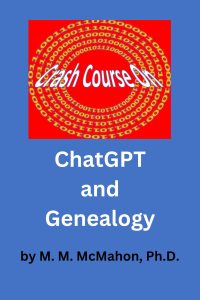
Let ChatGPT be your personal guide and research partner in genealogy. You do not have to be a computer wizard to benefit from ChatGPT! All you need to know is how to ask questions.
With a Ph.D. in Computer Science and Engineering and a dedication to genealogy, and as an educator at the undergraduate and graduate levels for more than 25 years, Dr. Mac sees the challenges students face to when they are learning, and remembers what it was like to be a new genealogist. With technical skills and expertise in genealogy, Dr. Mac experimented with ChatGPT to find out how best it can support your genealogical pursuits.
This book begins with how to get started with ChatGPT, leads you to ideas on how ChatGPT can become your personal genealogical research assistant, then shows example chats and example prompts.
More than enumerate lists of how ChatGPT can help, Dr. Mac goes the extra mile, showing you types of queries to use, and how to tailor those queries. There are specific examples to show the ways that ChatGPT can help you with your genealogy along with specific ideas on how to interact with ChatGPT about genealogy.
For reviews visit: Our page for this book
Crash Course on ChatGPT for Genealogy can be purchased through Amazon online in both print and Kindle versions online.

Researching U.S. WWI Military Members, Military Organizations and Noncombatants: A Research Guide for Historians and Genealogists
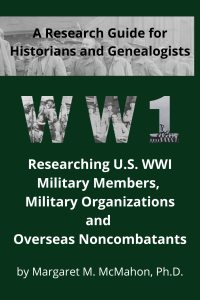
This book shows how you can learn about the service of a U.S. World War I military member, WWI military organizations and about noncombatants who went overseas. It will show you how to use a timeline to capture what you will learn during your WWI research. Learn to use a variety of resources including online records, social networking, archives and how to expand your search to other places where material from WWI can be found. It concludes with ideas to turn your research into a project that can be shared with others.
This book has been heavily revised and expanded from the original ” Researching Your U.S. WWI Army Ancestors” to include information about researching service members in the U.S. Navy, the U.S. Marine Corps, the U.S. Coast Guard and the Merchant Marine and along with the civilian noncombatants who went overseas to support the troops. The strategies presented can also be used in larger projects to research a military organization.
Dr. McMahon has decades of experience as a professional educator and engineer. She researches, lectures and has authored numerous books about military history and genealogy. She is the Unofficial Historian of the 51st Pioneer Infantry Regiment.
For reviews visit: Our page for the book
Researching U.S. WWI Military Members, Military Organizations and Noncombatants: A Research Guide for Historians and Genealogists can be purchased through Amazon online as a book online.

Write Their Story: From Timeline to Young Readers Book
We all want to share the family stories we have learned. Bringing research reports to family gatherings prompts yawns; writing a full-length book feels overwhelming. A book for young readers is in the “Goldilocks’ Zone” between those two extremes. This kind of book is a non-intimidating way to both write and share a story.
The process is simple. Choose the focus of the book. It can be the story of an immigrant family, or one ancestor’s military service, or any other significant person or time period in your family’s history. Collect the events, dates and places captured from your research effort. Then, construct a timeline. Then weave that timeline with the context of historical events and contemporary images into the fabric of an illustrated narrative. This process can help uncover holes in your research, and be expanded to the full-length book you have been wanting to write.
The book discusses an example book about the military service of a WWI Pioneer Infantryman in “Marching and Mules” that was created using this process.
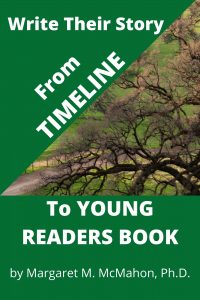
Write Their Story: From Timeline to Young Readers Book can be purchased through Amazon online as a book or as a Kindle book.

Marching and Mules: A U.S. Pioneer Infantryman in World War I (An illustrated book)
Young readers can follow Private 1st Class Joseph F. McMahon, a U.S. Army Pioneer Infantry Regiment soldier, during his service World War I (WWI) in images and text. This book is heavily illustrated with images from WWI sources. In images and text, the young reader begins with the start of WWI and how the U.S. joined the Allies. Through the pictures and text, young readers follow Joe as he begins with his journey from home to training at Camp Wadsworth in Spartanburg, SC, where he becomes a Pioneer Infantryman. He then travels to a port to embark on his voyage overseas to France. There is hard work to be done in France, leading to his Regiment taking part in the first American-led battle of WWI, the Battle of St. Mihiel. He spent time in Germany before returning home a year after they left. The book also contains a timeline with the key dates of PVT 1CL Joseph F. McMahon’s military service. This is an elementary book for younger readers, devotees of the Pioneer Infantry Regiments and those interested in WWI. Family historians may also benefit from learning how a timeline constructed from genealogical research can be brought to life by combining dry facts with the context of historical events and images, to weave the fabric of an illustrated narrative.
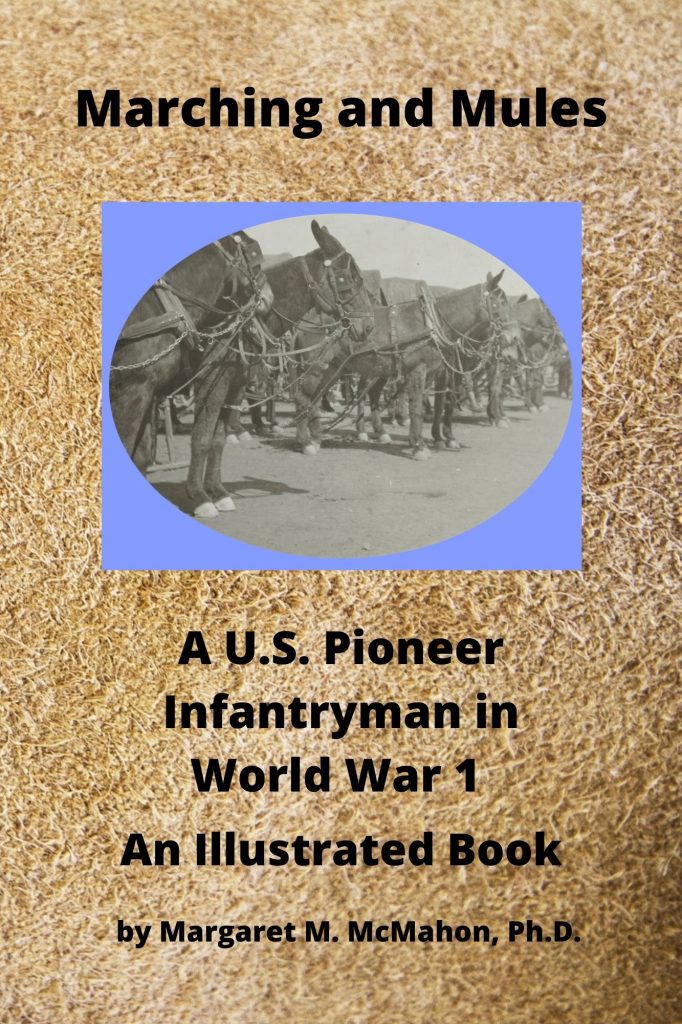
“Marching and Mules: A U.S. Pioneer Infantryman in World War I (An illustrated book)” can be purchased through Amazon online.

Guide to the U.S. Pioneer Infantry Regiments in WWI “They did everything the Infantry was too proud to do, and the Engineers too lazy to do.”
The Pioneer Infantry Regiments are usually mentioned in passing, or in the footnotes of history. The Pioneer Infantry Regiments were similar to regular army troops in that they were trained in infantry tactics, but they were also trained in combat engineering.
This book begins with material common to all the Pioneer Infantry Regiments. Origins, important dates, and training locations are included for each regiment. Sailing dates and ship names are given for those regiments that served overseas. Battle participation is included for regiments that saw combat. Other available material about each regiment has been included. Additional sources are listed for each regiment, as is material relevant to all of the regiments.
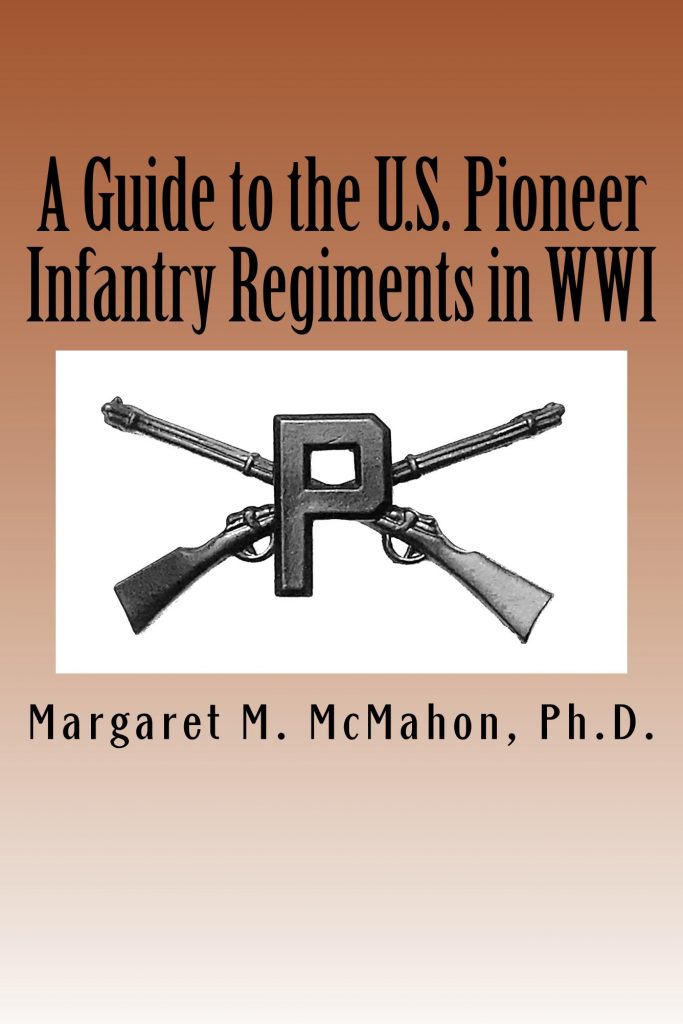
Read the Reviews for A Guide to the U.S. Pioneer Infantry Regiments in WWI
“A Guide to the U.S. Pioneer Infantry Regiments in WWI” can be purchased through Amazon online.

With Rifle and Shovel: The 51st Pioneer Infantry Regiment in WWI Want to know more about the lives of 51st Pioneer Infantry Regiment members in WWI? The members of the 51st Pioneer Infantry Regiment The men of the 51st Pioneer Infantry were mostly draftees. They fought with rifles; they used shovels. They also saw combat. As shells went off around them, the pioneers filled holes with rubble collected from destroyed villages.
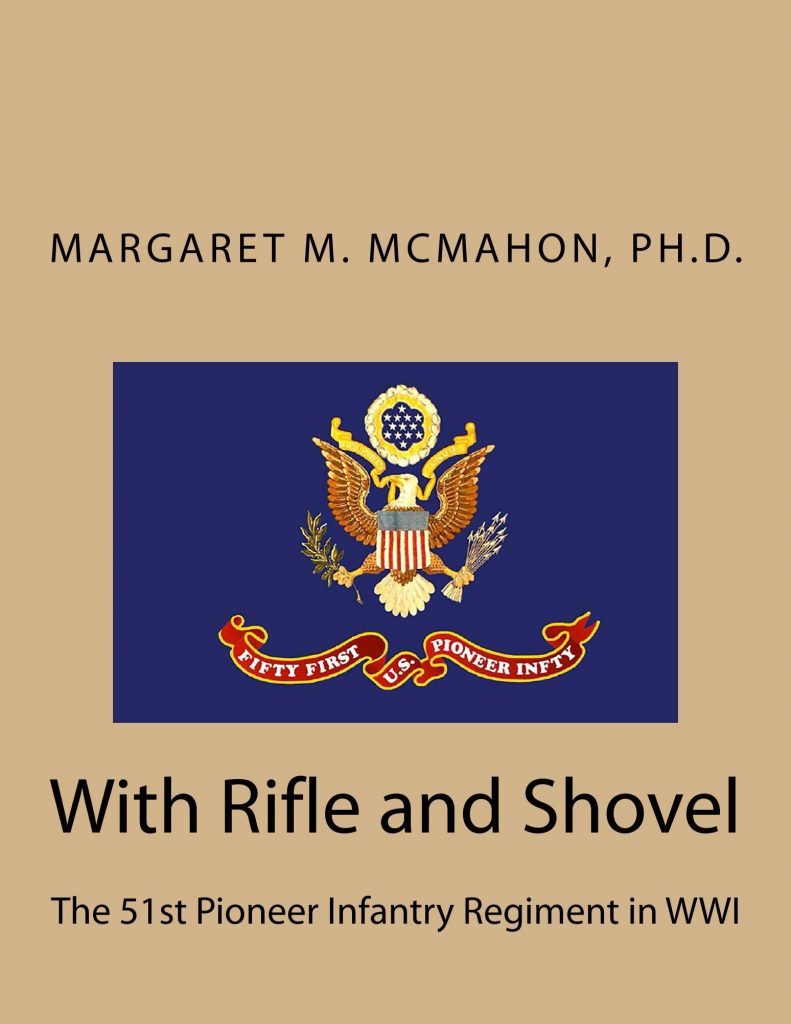
Read the Reviews for With Rifle and Shovel
“With Rifle and Shovel: The 51st Pioneer Infantry Regiment in WWI” can be purchased through Amazon online.

Researching Your U.S. WWI Army Ancestors Are you ready to research your U.S. WWI Army Ancestor? Are you wondering how to get started? With the approaching centennial of the United States’ involvement in the War to End All Wars (World War I), our thoughts turn to those ancestors who defended our freedom. This book will show you how to learn about the military service of your U.S. Army ancestors using archives, online resources, social networking and other resources. Learn ways to share what you learn to with others.

Read the Reviews for Researching Your WWI U.S. Army Ancestors
NOTE: The updated and expanded book is recommended. Researching U.S. WWI Military Members, Military Organizations and Noncombatants: A Research Guide for Historians and Genealogists
<! BUY THE BOOK >

A Weekend of Genealogy: Things to Know and Do, Online and Offline focuses on a weekend of genealogical research activities centered on the U.S. Federal Census and Internet searching. Activities to do before and after the weekend are also included. The book includes hints, websites, and search terms useful for your research activity.
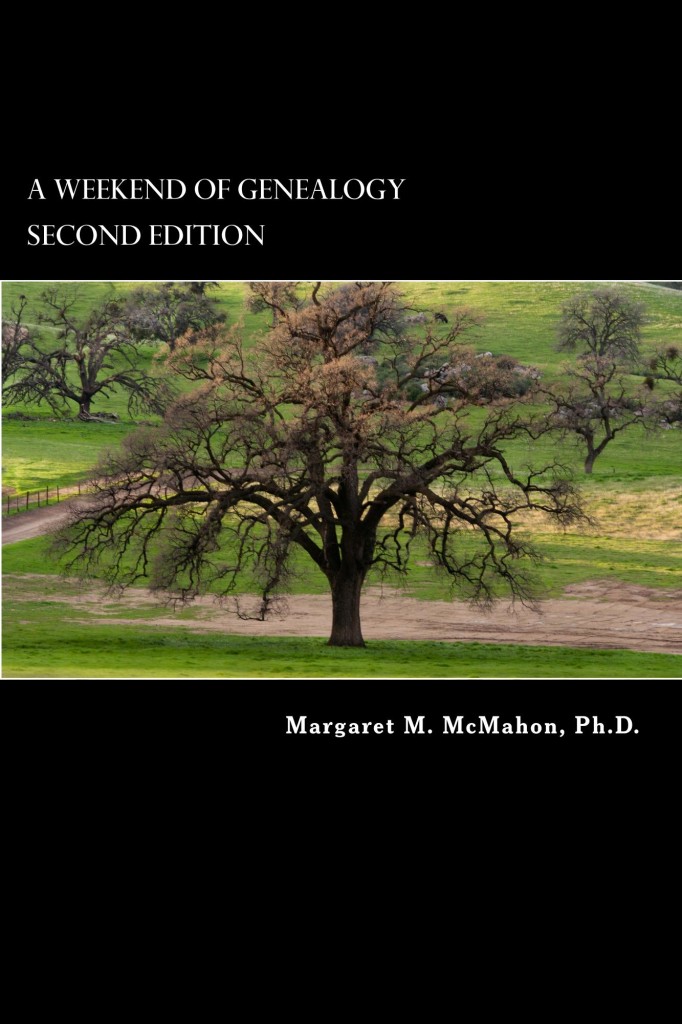
Read the Reviews for A Weekend of Genealogy
Table of Contents
Introduction
FRIDAY NIGHT: Get Ready
SATURDAY: The Federal Census
SATURDAY: Where is Your Ancestor?
BEYOND SATURDAY: More to Do and More Censuses
SUNDAY: Google for Genealogy
BEYOND SUNDAY: More Internet Searching
Online Safety
Concluding Thoughts
The Second Edition of “A Weekend of Genealogy” can be purchased through Amazon online.

A Week of Genealogy: Things to Know and Do, Online and Offline contains seven days of activities and what to do before and after your week of genealogy.

Read the Reviews for A Week of Genealogy
Table of Contents
Introduction
BEFORE DAY 1: Preliminary Steps
DAY 1: Timelines
DAY 2: Birth / Marriage / Death Records
DAY 3: Social Security Death Index
DAY 4: Newspapers
DAY 5: Cemetery Records on line
DAY 6: Military Records
DAY 7: Finding Research Help on the Web
AFTER DAY 7: What to do with all you find
The Second Edition of “A Week of Genealogy” can be purchased through Amazon online.

For groups wishing to order multiple copies, contact us at aweekofgenealogy@gmail.com.
UPDATES on Edition 1
“A Weekend of Genealogy”
The tilde (~) operator that was described on pages 54-55 of the book has been dropped by Google. A workaround is discuss in the blog post about Google Searches.


